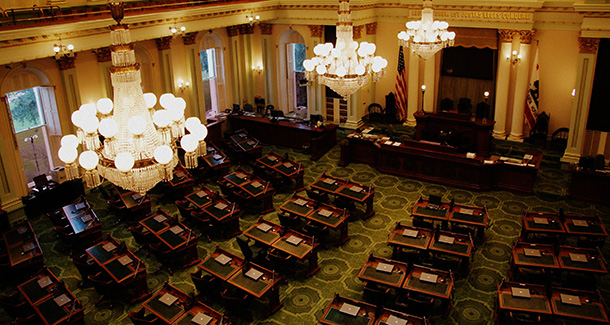
31 of the 120 California Legislature members are women. (California Assembly Chamber Photo Credit: LWYang/Flickr)
The headlines from last week’s primary election in California looked pretty promising for female candidates. Hillary Clinton virtually wrapped up the Democratic Presidential nomination with her victory in California and it was assured that a woman would succeed Barbara Boxer as U.S. Senator.
California Women Lead, a non-partisan non-profit group sees the results a little differently: The number of California women in Congress and the Legislature will decline this year.
“There is still much work to be done for women in elected office in California,” said Rachel Michelin, California Women Lead Executive Director/CEO. “While it is great news that we will replace Senator Barbara Boxer with another woman, it is disappointing that we are losing three congressional seats that were previously held by women.”
The results from state Assembly and Senate races are not as dire, but Michelin fears there could be a net loss in each house after the November elections.
“As we look forward to future elections, California Women Lead is committed to recruiting and training women to run for elected office, especially at the Congressional level. That is also why our work at the state level is so important – that is the farm team for women aspiring to run for higher office,” she added.
Women represent about one-fourth of the California Legislature—31 of the 120 members.
At CA Fwd, we pay attention to these kind of development because “for democracies to work, elected leaders need to be responsive and representative, and voters must be able to hold elected officials accountable for results.”
Helen Hutchison, who heads the California League of Women Voters agrees.
“It’s important for those who represent us in government to look like California. This includes gender. A lot of people — particularly those who aren’t well represented in the electorate or in our government — don’t understand or trust government. They don’t see a path to run for office. More women and people of color running for elected office and representing their communities’ benefits all of us.”
The news at the local level is mixed. Two women serve as mayors of the state’s 12 largest cities and one of them, Fresno’s Ashley Swearengin is termed out this year and will be replaced by a male mayor. In Los Angeles, however, the five-person County Board of Supervisors could possibly have a female majority in November. There are two open seats and last week women were the top vote getters in both of those races.
Michelin said the same may be true in El Dorado County where she lives. “Actually, we are doing better with county supervisors,” she pointed out.
California Women Lead this year held a training for women interested in running for office and being appointed to boards and commissions in Southern California and plans one for Northern California next year.
“There is still lot of work to do raise awareness,” said Michelin. “But we are making progress.”

